MSI B85M ECO Review: Aiming Green at $73
by Ian Cutress on November 26, 2014 8:00 AM EST- Posted in
- Motherboards
- MSI
- B85
- ECO
System Benchmarks
Power Consumption
Power consumption was tested on the system while in a single MSI GTX 770 Lightning GPU configuration with a wall meter connected to the OCZ 1250W power supply. This power supply is Gold rated, and as I am in the UK on a 230-240 V supply, leads to ~75% efficiency > 50W, and 90%+ efficiency at 250W, suitable for both idle and multi-GPU loading. This method of power reading allows us to compare the power management of the UEFI and the board to supply components with power under load, and includes typical PSU losses due to efficiency. These are the real world values that consumers may expect from a typical system (minus the monitor) using this motherboard.
While this method for power measurement may not be ideal, and you feel these numbers are not representative due to the high wattage power supply being used (we use the same PSU to remain consistent over a series of reviews, and the fact that some boards on our test bed get tested with three or four high powered GPUs), the important point to take away is the relationship between the numbers. These boards are all under the same conditions, and thus the differences between them should be easy to spot.
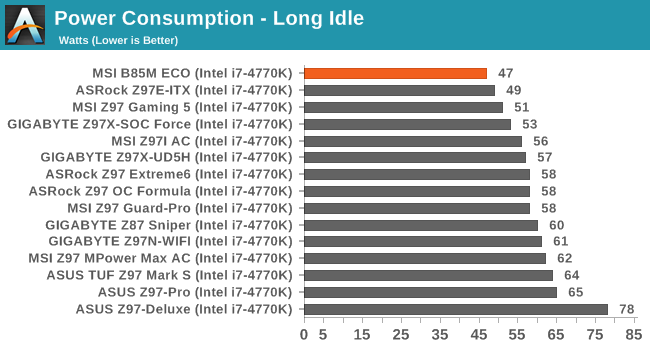
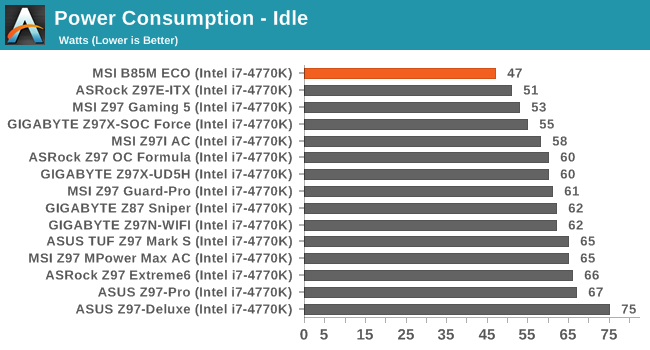

As mentioned previously in the review, when we set the B85M ECO up in the same test bed as our other Haswell-capable motherboards, it goes straight to the top of the list in long idle, idle and load power consumption.
For our 500W Platinum results on the B85M ECO, please refer back to the second page ‘Doing the Math on ECO’. For reference, with the i7-4770K on that power supply, we achieved 40W at long idle and 104W at peak loading.
Windows 7 POST Time
Different motherboards have different POST sequences before an operating system is initialized. A lot of this is dependent on the board itself, and POST boot time is determined by the controllers on board (and the sequence of how those extras are organized). As part of our testing, we look at the POST Boot Time using a stopwatch. This is the time from pressing the ON button on the computer to when Windows 7 starts loading. (We discount Windows loading as it is highly variable given Windows specific features.)

For a system that is heavily stripped, 12.5 seconds might seem like a long POST time. Bear in mind that that B85 is not particularly a platform for POST optimization, compared to the high average selling price market such as the OC Certified and Gaming ranges.
Rightmark Audio Analyzer 6.2.5
Rightmark:AA indicates how well the sound system is built and isolated from electrical interference (either internally or externally). For this test we connect the Line Out to the Line In using a short six inch 3.5mm to 3.5mm high-quality jack, turn the OS speaker volume to 100%, and run the Rightmark default test suite at 192 kHz, 24-bit. The OS is tuned to 192 kHz/24-bit input and output, and the Line-In volume is adjusted until we have the best RMAA value in the mini-pretest. We look specifically at the Dynamic Range of the audio codec used on board, as well as the Total Harmonic Distortion + Noise.
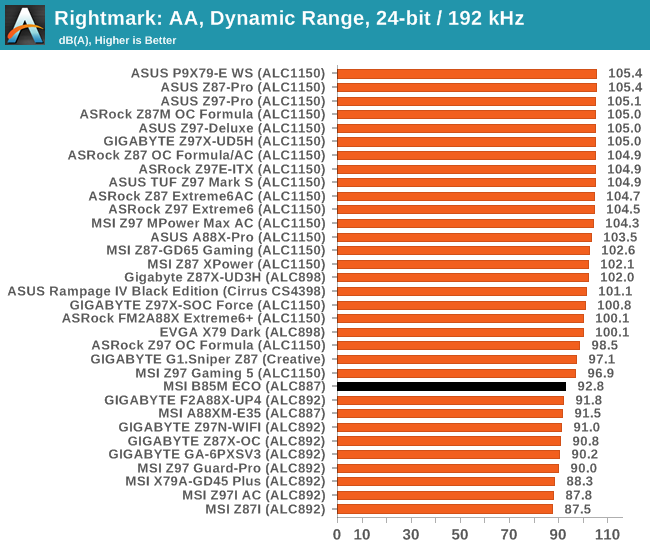
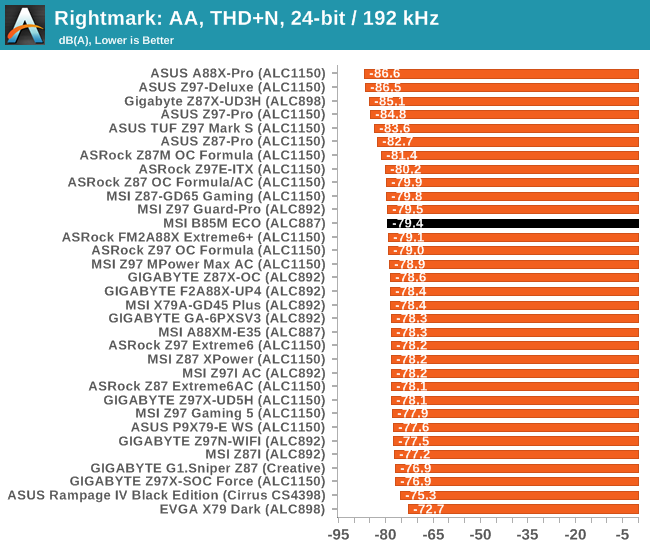
Using an ALC887 audio codec was never going to break any records for audio, but it does as well as can be expected.
USB Backup
For this benchmark, we transfer a set size of files from the SSD to the USB drive using DiskBench, which monitors the time taken to transfer. The files transferred are a 1.52 GB set of 2867 files across 320 folders – 95% of these files are small typical website files, and the rest (90% of the size) are small 30 second HD videos. In an update to pre-Z87 testing, we also run MaxCPU to load up one of the threads during the test which improves general performance up to 15% by causing all the internal pathways to run at full speed.
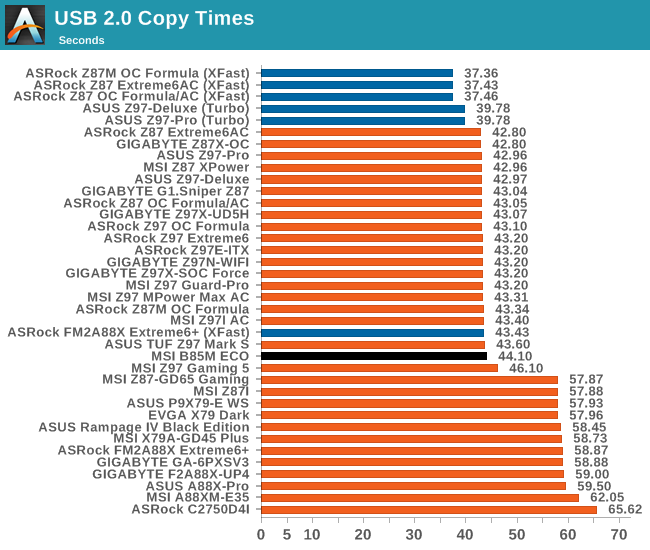
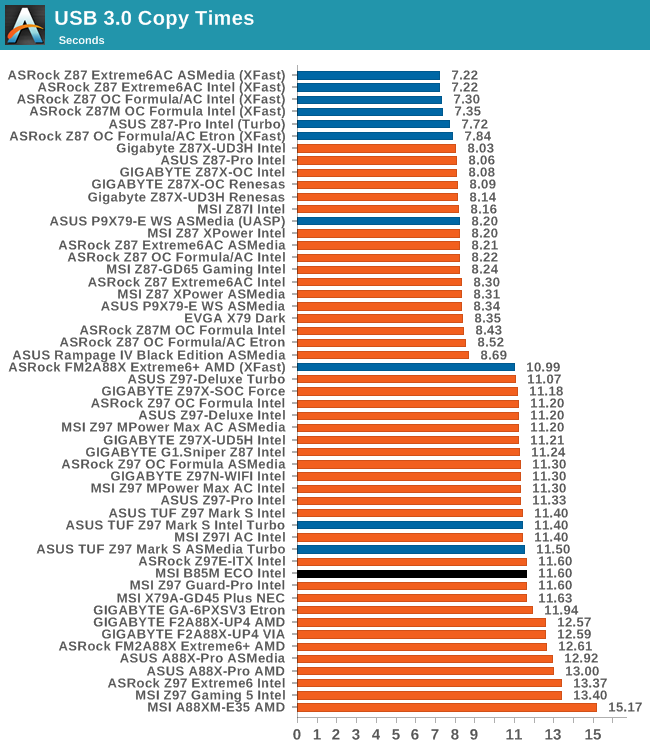
DPC Latency
Deferred Procedure Call latency is a way in which Windows handles interrupt servicing. In order to wait for a processor to acknowledge the request, the system will queue all interrupt requests by priority. Critical interrupts will be handled as soon as possible, whereas lesser priority requests such as audio will be further down the line. If the audio device requires data, it will have to wait until the request is processed before the buffer is filled.
If the device drivers of higher priority components in a system are poorly implemented, this can cause delays in request scheduling and process time. This can lead to an empty audio buffer and characteristic audible pauses, pops and clicks. The DPC latency checker measures how much time is taken processing DPCs from driver invocation. The lower the value will result in better audio transfer at smaller buffer sizes. Results are measured in microseconds.
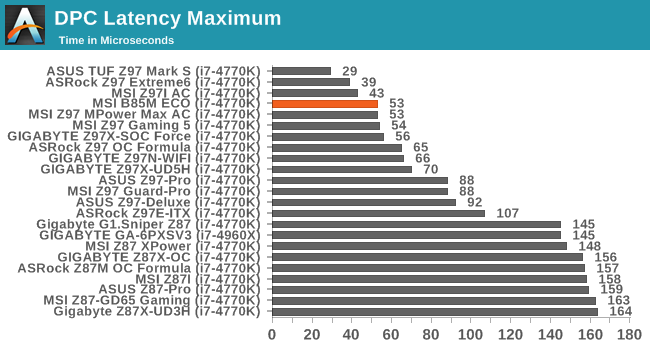
For whatever reason, I had in the back of my mind that an ECO-oriented board would not be that good in DPC Latency. I was greatly surprised when it achieved just over 50 microseconds and into the top part of our result list.










40 Comments
View All Comments
Jaaap - Wednesday, November 26, 2014 - link
For these ECO boards it would be very interesting to get and idle power for a setup without external videocard.Jaaap - Wednesday, November 26, 2014 - link
Arg i should read better: 21W minimumklagermkii - Wednesday, November 26, 2014 - link
Thanks for showing separate idle and load power usage in the review and not just delta.bill.rookard - Wednesday, November 26, 2014 - link
The area I think where this would do fairly well would be as a SMB server. I know I tend to keep things for far longer than 5 years which would be the break even point on the cost - once they have something that works, and works well (and works correctly) they'll leave it in place until it dies, and for something as simple as file serving, you just want something durable and reliable.mike_m_ekim - Friday, December 12, 2014 - link
Another great use is a HTPC. My HTPC uses a 35-watt haswell CPU. Passive cooling isn't an option because of location, so fans are required. Another 10 watt reduction in system heat would allow the fans to run just a little slower, making my nearly silent PC even quieter.mike_m_ekim - Friday, December 12, 2014 - link
One other thing, my HTPC is on 24/7 and transcoding almost all the time. I would see a $25 savings in electricity over 3 years, and an HTPC should be able to last much longer (because it's just an appliance). The cost savings would be secondary (noise being the biggest factor).MrSpadge - Wednesday, November 26, 2014 - link
My PC is number-crunching 24/7, so saving 12 W would save me about 6€/year (yeah, no fracking in Germany). A Z97 ECO could be interesting, because even with massive undervolting to ~1.0 V, current Intel CPUs are still asking to be OC'ed to ~4.0 GHz. I couldn't do that with a B chipset.DanNeely - Wednesday, November 26, 2014 - link
Is your math right? Your cost saving number seems low. For 24/7/365 operation a 1W load corresponds to 8.76 kwh/year; at an electricity price of 11.5 cents per kwh (reasonably close for most of the US) it works out as a dollar per wattyear or $12/year savings. My understanding is that German electric prices are several times higher, and am wondering if you lost a zero in your calculations.Jaaap - Wednesday, November 26, 2014 - link
You're right. One WattYear is approx 2 euro.MrSpadge - Wednesday, November 26, 2014 - link
8.76 kWh for 11.5 US-ct -> 1 W = 1 $/year in the US8.76 kWh for 23 EUR-ct -> 1 W = 2 €/year in Germany
... the cost is higher over here, but not an order of magnitude :)